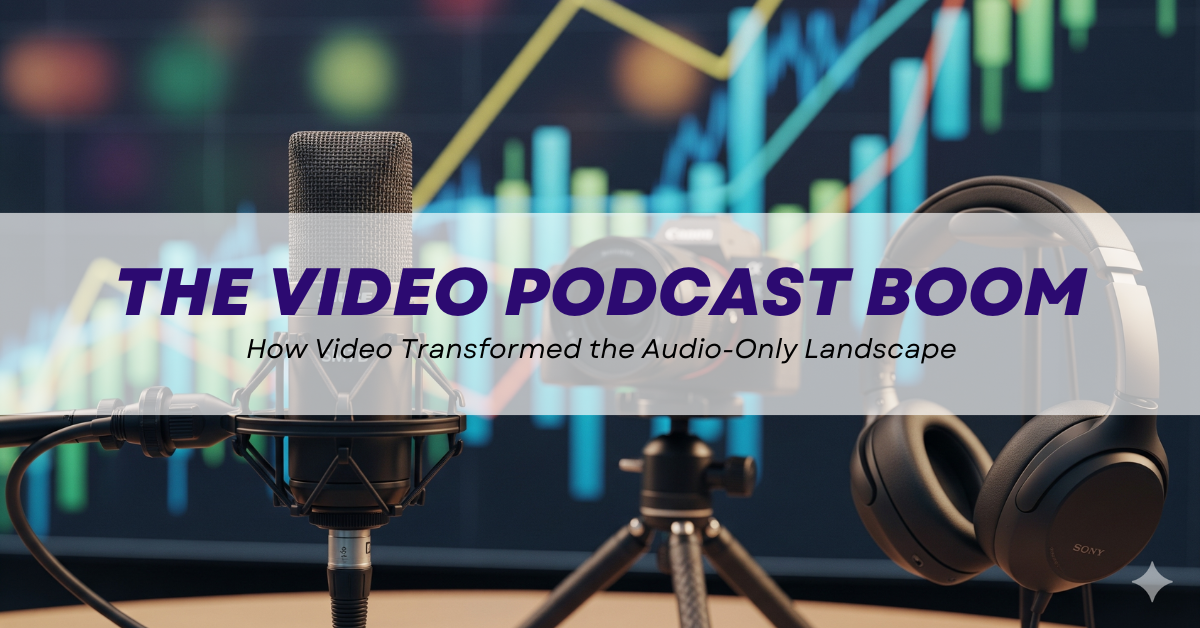Video podcasts aren't new. They’ve existed since the early 2000s, with pioneers like "Dead End Days" proving the concept. But for years, they were a n
Video podcasts aren’t new. They’ve existed since the early 2000s, with pioneers like “Dead End Days” proving the concept. But for years, they were a niche pursuit, dominated by individual creators while brands largely stuck to audio.
Just five years ago, the landscape was completely different. Branded video podcasts were a rarity. Episodes were distributed as full, long-form pieces, with clip marketing barely a consideration. Video quality often took a backseat, with many brands simply slapping a static cover image over an audio file and uploading it as an MP4. The format was simple, often just a static shot of a 1:1 interview, with all the optimization efforts focused on sound, not sight.
So, what changed? The explosion of video podcasting is a story of platform evolution, changing audience habits, and a strategic pivot by creators and brands to meet this new demand.
The Catalysts of Change
The shift began gradually. Three years ago, it was still uncommon for a brand to post a full video episode on YouTube. Then, several key events accelerated the trend:
- Spotify’s Video Push: In 2020, Spotify entered the video podcasting space with a beta program, opening it to all creators by 2021. Its acquisition of Anchor created a seamless, integrated hosting and uploading system specifically for video podcasts, legitimizing the format on a major audio-first platform.
- The Short-Form Video Revolution: The meteoric rise of TikTok, Instagram Reels, and YouTube Shorts created a perfect distribution channel for podcast clips. These platforms became the new “front door,” allowing creators to offer enticing previews and drive audiences to their full-length episodes.
- Platforms Embracing Long-Form: Ironically, while short-form boomed, platforms simultaneously began rewarding long-form content. YouTube, in particular, optimized its algorithm for watch time, making well-produced, engaging long-form videos like podcasts incredibly valuable for keeping users on the platform.
The Major Players Today
The video podcasting ecosystem is now driven by a few key platforms, each with a unique role.
YouTube: The Long-Form Giant
YouTube’s journey from a home for short clips to a hub for long-form content is well-documented. With the average podcast episode falling between 30-45 minutes, YouTube is a natural home. The platform rewards the high volume of engaging, long-form content that a video podcast strategy produces. Their reported development of a dedicated “Podcasts” section confirms their serious investment in this space. As A.J. Feliciano, Head of Podcast Network, notes, YouTube offers “a seamless creator experience, plus SEO marketing tools, plus the benefit of being a platform most have been conditioned to enjoy.”
Spotify: The Audio App Going Visual
Spotify’s aggressive acquisitions—from Anchor to Gimlet Media and The Joe Rogan Experience—signaled its intent to dominate podcasting. The move to video was a strategic next step to increase listener (and now viewer) retention within its app. By leveraging Anchor’s hosting as the sole upload path for video, Spotify has created a unique, integrated ecosystem that ties creators closely to its platform.
TikTok: The Discovery Engine
TikTok is not yet a destination for full episodes, but it’s arguably the most powerful discovery tool for podcasts. Its algorithm is perfectly suited for sharing compelling, short clips that hook viewers and encourage them to seek out the full show. Furthermore, with TikTok increasing its video length limit to 10 minutes and reportedly exploring a dedicated podcast function, its role is poised to expand significantly.
New Data on Viewer Preferences (August 2025)
The trend toward video is not just industry speculation; it’s backed by listener data. According to a June 2025 report from Populix, consumer preferences, particularly in key markets like Indonesia, have shifted dramatically toward video.
The research revealed that Indonesians now strongly prefer video-only podcasts over audio-only ones. In fact, since 2023, the number of podcast listeners who only listen to audio has decreased by more than half. Perhaps most importantly, two out of three video podcast listeners report watching the entire episode from start to finish, indicating a powerful and engaging format.
This shift opens significant monetization avenues, from product placement and visual ad reads to affiliate links and paid subscriptions. However, as James Cridland, Editor of Podnews, cautions, this advertising boom can be a “double-edged sword,” potentially impacting content quality and creator independence if not managed carefully.
The New Challenges: Cost, Competition, and Comments
This gold rush comes with its own set of challenges. The barrier to entry has been raised significantly.
- Increased Cost & Effort: What was once a low-cost medium now often requires a full production team, equipment, editing, and considerations for lighting, set design, and appearance. As Joe Cilio of Forever Dog Productions stated, “No doubt video has increased the cost and amount of personnel.”
- Fierce Competition: On YouTube, you’re not just competing with other podcasts; you’re competing with every video on the internet. Optimizing titles, thumbnails, and the crucial first 60 seconds to win over a scrolling audience is now a required skill.
- The Human Toll: Creators used to the supportive “pod-famous” community can be unprepared for the harsh negativity of broader platform comments. This “price of engagement” can weigh heavily on hosts.
The Bottom Line
The question is no longer if video is a part of podcasting’s future, but how creators and brands will effectively integrate it. Video is no longer a bonus; it’s a central strategy for discovery, audience growth, and monetization.
The platforms are all-in, the audience appetite is proven, and the tools are more accessible than ever. For smart creators, this is a uniquely opportune moment to harness the power of video to build deeper loyalty and unlock new growth. The era of the video podcast is firmly here.


COMMENTS